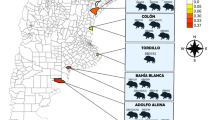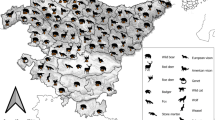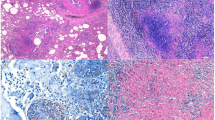Abstract
Poland is officially free of animal tuberculosis (TB), caused by Mycobacterium bovis and closely related members of the Mycobacterium tuberculosis complex, including Mycobacterium caprae. Sporadic cases of infection have been reported in cattle, but also in free-ranging species such as European bison (Bison bonasus), red deer (Cervus elaphus), Eurasian wild boar (Sus scrofa), Eurasian lynx (Lynx lynx), and Eurasian badger (Meles meles). This paper presents the history and recent findings regarding the incidence of tuberculosis in a free-living European bison herd and the possibility of interspecific transmission of the agent to other wildlife. The spoligotyping method indicated that the isolated strains belong to M. caprae showing spoligo pattern 2000037777377400. The results of these and earlier studies suggest that this M. caprae strain could be transferred from bison to wild boar.


Similar content being viewed by others
References
Aranaz A, de Montero JL, Sánchez N, Galka C, Delso M, Alvarez C, Romero J, Bezos J, Vela J, Briones AI, Mateos VA, Domínquez L (2004) Bovine tuberculosis (Mycobacterium bovis) in wildlife in Spain. J Clin Microbiol 42:2602–2608
Beltrán-Beck B, de la Fuente J, Garrido JM, Aranaz A, Sevilla I, Villar M, Boadella M, Galindo RC, Pérez de la Lastra JM, Moreno-Cid JA, Fernández de Mera IG, Alberdi P, Santos G, Ballesteros C, Lyashchenko KP, Minguijón E, Romero B, de Juan L, Domínguez L, Juste R, Gortázar C (2014) Oral vaccination with heat inactivated Mycobacterium bovis activates the complement system to protect against tuberculosis. PLoS One. doi:10.1371/journal.pone.0098048
Bengis RG, Kock RA, Fischer J (2002) Infections animal diseases: the wildlife/livestock interface. Rev Sci Tech Int Epiz 21:53–65
Brewczyński P (2013) The current activities for protection and breeding of European bison in Bieszczady. Europ Bison Conserv Newslett 6:123–132
Brewczyński P, Welz M (2011) Threat of tuberculosis of European bison in the Bieszczady. Europ Bison Conserv Newslett 4:63–70
De Lisle GW, Mackintosh CG, Bengis RG (2001) Mycobacterium bovis in free-living and captive wildlife, including farmed deer. Rev Sci Tech Int Epiz 20:86–111
De Vos V, Bengins RG, Kriek NP, Michel AA, Keet DF, Raath JP, Huchzermeyer HF (2001) The epidemiology of tuberculosis in free-ranging African Buffalo (Syncerus caffer) in the Kruger National Park, South Africa. J Vet Res 68:119–130
Delahay RJ, Smith GC, Barlow AM, Walke N, Harris A, Clifton-Hadley RS, Cheeseman CL (2007) Bovine tuberculosis infection in wild mammals in the South-West region of England: a survey of prevalence and a semi-quantitative assessment of the relative risks to cattle. Vet J 173:287–301
Gallagher J, Clifton-Hadley RS (2000) Tuberculosis in badgers; a review of the disease and its significance for other animals. Res Vet Sci 69:203–217
Gortázar C, Delahay R, McDonald R, Boadella M, Wilson G, Gavier-Widen D, Acevedo P (2012) The status of tuberculosis in European wildlife. Mammal Rev 42:193–206
Gortázar C, Diez-Delgado I, Barasona J, Vicente J, de_la_Fuente J, Boadela M (2015) The wild side of disease control at the wildlife-livestock-human interface: a review. Front Vet Sci. doi:10.3389/fvets.2014.00027
Kamerbeek J, Schouls L, Kolk A, van Agterveld M, van Soolingen D, Kuijper S, Bunschoten A, Molhuizen H, Shaw R, Goyal M, van Embden J (1997) Simultaneous detection and strain differentiation of Mycobacterium tuberculosis for diagnosis and epidemiology. J Clin Microbiol 35:907–914
Krajewska M, Lipiec M, Zabost A, Augostynowicz-Kopeć E, Szulowski K (2014) Bovine tuberculosis in a wild boar (Sus scrofa) in Poland. J Wildl Dis. doi:10.7589/2013-07-187
Michel AL, Bengins RG, Keet DF, Hofmeyer M, Klerk LM, Cross PC, Jalles AE, Cooper D, Whyte IJ, Buss P, Godfroid J (2006) Wildlife tuberculosis in South African conservation areas: implications and challenges. Vet Microbiol 112:91–100
Nishi JS, Shury T, Elkin BT (2006) Wildlife reservoirs for bovine tuberculosis (Mycobacterium bovis) in Canada: strategies for management and research. Vet Microbiol 112:325–338
Tanner M, Inlameia O, Michel A, Maxlhuza G, Pondja A, Fafetine J, Macucule B, Zacarias M, Manguele J, Moiane IC, Marranangumbe AS, Mulandane F, Schönfeld C, Moser I, van Helden P, Machado A (2014) Bovine tuberculosis and brucellosis in cattle and African buffalo in the Limpopo National Park. Mozambique Transbound Emerg Dis. doi:10.1111/tbed.12210
Wee SH, Kim CH, More SJ, Nam HM (2010) Mycobacterium bovis in Korea: an update. Vet J 3:347–350
Welz M (2010) The epizootic situation among livestock and the wildlife in the area of Bieszczady Mountains considering the Mycobacterium bovis infections. Dissertation. Warsaw University of Life Sciences- SGGW
Welz M, Anusz K, Salwa A, Zalewska M, Bielecki W, Osińska B, Kaczor S, Kita J (2005) Bison tuberculosis in Bieszczady. Med Weter 61:441–444
Żórawski C, Lipiec M (1997) Generalized tuberculosis in European bison. Med Weter 53:90–92
Compliance with ethical standards
We confirm that all research carried out in the preparation of the article titled “Transmission of Mycobacterium caprae in a herd of European bison in the Bieszczady Mountains, Southern Poland” were conducted in accordance with the basic laws of ethics. We declare that there were no studies on humans or animals, and there was no need to apply for a permission of the Local Ethics Committee.
This manuscript has not been published elsewhere and is not under consideration by another journal. All authors have approved the manuscript and agree with its submission to the European Journal of Wildlife Res.
Conflict of interest
We declare that there is no conflict of interest.
Author information
Authors and Affiliations
Corresponding author
Additional information
Communicated by C. Gortázar
Rights and permissions
About this article
Cite this article
Krajewska, M., Zabost, A., Welz, M. et al. Transmission of Mycobacterium caprae in a herd of European bison in the Bieszczady Mountains, Southern Poland. Eur J Wildl Res 61, 429–433 (2015). https://doi.org/10.1007/s10344-015-0912-x
Received:
Revised:
Accepted:
Published:
Issue Date:
DOI: https://doi.org/10.1007/s10344-015-0912-x




